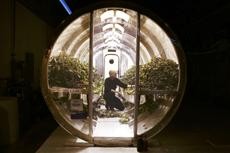Astronauts could soon be eating fresh vegetables on the moon with the help of UA’s lunar greenhouse.
The Controlled Environment Agriculture Center at the UA has worked on their lunar greenhouse for about a year and they now have a fully functional greenhouse that could one day grow crops on the moon.
“”What we want to do in the long term is provide life support through a greenhouse that’s growing plants,”” said CEAC Director Gene Giacomelli. “”It’s not life support just to feed people, it’s relatively easy to get food to the moon, it’s harder to get oxygen and fresh water.””
The lunar greenhouse includes a variety of crops including sweet potatoes, strawberries, romaine lettuce and tomatoes.
“”One of the reasons the sweet potato is such a great idea for space applications is because not only can you eat the plant root but you can also eat the leaves,”” said Lane Patterson, a masters student in agricultural and biosystems engineering.
The plants inside the greenhouse produce enough oxygen for one person, as well as enough water and about half of a day’s worth of calories.
“”It means eating a lot of salads,”” Giacomelli said. “”If it gives you half your food, all your water and all your oxygen then you’re not in too bad of shape…you could go forever.””
The center’s goal is to eventually, with the help of Sadler Machine Company, build four greenhouses to support four people on the moon.
“”The moon will become the step off point for the rest of the solar system and the rest of the universe,”” said Giacomelli.
Patterson also wants to test the lunar greenhouse in extreme environments.
“”I would like to see – one of these days – that we make some modifications such that it can be transported to Antarctica, buried in the snow and then we can do some hazardous extreme environment trials,”” he said.
The biggest concern that Giacomelli and his students have right now is figuring out an appropriate power source for the greenhouse.
“”Right now we obviously just plug it into the wall, “” Giacomelli said. “”The most limiting factor is energy.””
There are two real options for energy usage on the moon, he said. One is to have a small nuclear powered generator and the other is to harvest the sunlight.
“”(Nuclear powered generators) do exist but it’s very controversial to use that,”” he said. “”Harvesting sunlight would be the more sustainable approach.””
Craig Wheeler, a plant sciences senior who also works on the lunar greenhouse, said he hopes that one day the project will be part of NASA’s agenda.
“”It’s a very unique piece of technology and it’s a sweet piece of engineering,”” he said. “”I hope that the program continues enough and it’s adopted into what NASA plans to do on the moon.””
Giacomelli said he also thinks that the lunar greenhouse is attracting more students to agricultural degrees.
“”They don’t always want to become a farmer or a grower,”” he said. “”I mean this isn’t your grandfathers farm, this is high technology.””
He said he hopes that in the future, the principles of the lunar greenhouse could be applied to solve some of the Earth’s problems.
“”(Recycling) is something we’re going to have to do more and more on earth and there’s a lot of interest right now in growing systems in building or in urban areas,”” Giacomelli said. “”I would like to see that before I die.””









